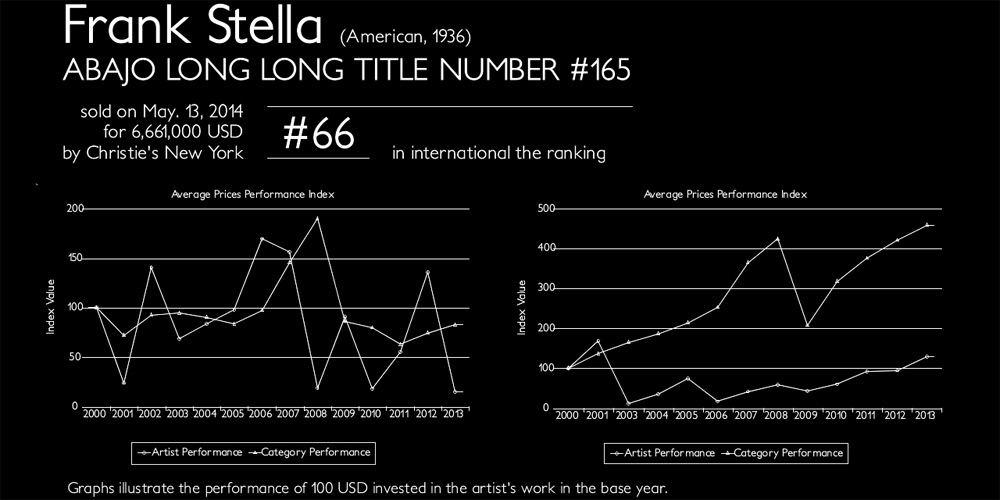
Photo: Martin Hieslmair
Who actually owns a work of art? Is it the artist, the collector or even the public? And who pays how much for it? The 22-year-old Rosi Grillmair thought about that. She is studying “Time-based and Interactive Media” at the Linz University of Art. Now she presents her “Art Retriever” at the exhibition “TIME OUT .02” of the Ars Electronica Center – a visualization that relies on the auction results of current art auctions and which presents the most expensive works of art of the most successful artists in the world.
Recently, an oil painting by Pablo Picasso has been sold in New York for over 30 million U.S. dollars. Is a work of art really worth that much?
Rosi Grillmair: My project “The Art Retriever” approaches exactly this topic of art markets and questions the conflict between the material value of a picture and its ideal value, which everybody can define for a work of art individually. A monetary value is a value that can be set up and clearly defined by everybody – if you want to trade it on the art market, it has to be reduced to the only comparable value that is available for art: the material value. In an ideal value, the comparison is not possible in this way. But how can artists become generally known if anyone sees their works? To whom belongs the artwork after its sale? To Artists, to collectors, or – when we have to deal with a well-known artists such as Pablo Picasso – to the public if we look at it as a cultural heritage?
If we look at it very naively and a work of art has a very high value and was sold for so much money then it must also be a very good picture indeed.
This could be a plausible reason, right? And if it’s so special, it is certainly important that it also can be seen by everyone? But often these sold pictures remain as pure capital goods and are put into depots as private property until they again will be resold. And as the works of art now have such a high market value, museums and public institutions are reliant on art collectors or sponsors who have enough money for these kind of purchases. With the high price on the art market also the market value of a picture increases, but at the same time the chance to show them to the public decreases.

Photo: Rosi Grillmair
What does the „Art Retriever“ make visible?
Rosi Grillmair: My project retrieves art works back from their existence as pure capital and makes it visible to the public as a digital copy in a large photo frame – regardless of whether it might have been bought at this very moment by a private individual for millions or not. The more important and expensive works of art are the more they are present in my project. The more data there is available about them, the more money was spent and the more owners could be recorded the more visible gets the picture in the visualization, which is formed in a slow process of words and numbers. Relatively unknown and less expensive picture are also less present, a Picasso for example, however, is almost completely visible.

Photo: Martin Hieslmair
Where does the data come from?
Rosi Grillmair: The data is retrieved on a daily basis from an online database. Here all artists are listed that have ever sold a work – their ranking is calculated by several factors: sales prices and market value of works of art, productivity of the artists or the number of exhibitions in which the picture was exhibited. Step by step the “Art Retriever” bring these “big” names back to screen, from 100 to 1. It demonstrates how much works of art have become capital goods. From everyone of these artists the currently most expensive picture will be shown that has been sold on the art market.
Technically, a script checks through a premium account of this website regularly and reads out the data from an HTML page. Another online database delivers more information about the artists that is displayed on a small screen next to the actual picture. Here investors can analyze the careers of artists – how productive will be an artist next year? They can consider whether they will put money into it or not. Thus, the artists are reduced to production machines, on which you can then almost bet. How successful were they when with what? Is it better to invest here in sculptures or in installations? It is no longer about the work of art itself.

Rosi Grillmair, Photo: Florian Voggeneder
How did it happen that you have come to deal with this topic?
Rosi Grillmair: At the HBLA for art in Linz I have designed a board game where the players act as artists who have set themselves the goal to exhibit their works of art in a museum. The players are able to collect playing cards and therefore stations of their own CVs – this defines if you make it to a museum or not. Then I have produced a film about a fictional exhibition in which all stakeholders, such as curators, critics and professors come to speak about it but not the artists. Again, I have dealt with the question of who actually filters and determines what works will be at a museum and are thus presented to the public. Of course, you can not exhibit everything in a museum and there are always selections. I was impressed by the fact that 95% of all works of art in the world are hidden in a depot.
The exhibition “TIME OUT .02” at the Ars Electronica Center Linz is on show until the end of August 2014. More infos about the “Art Retriever” you will find on theartretriever.wordpress.com.
